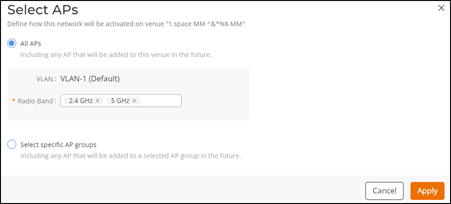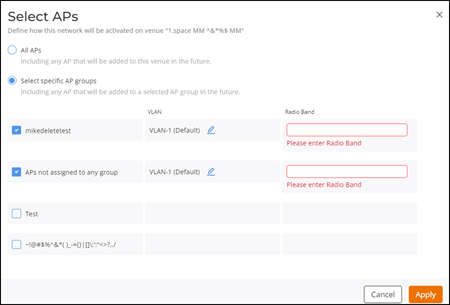Creating a Network That Uses a Cloudpath Captive Portal
You can learn to create a network that allows users to connect through an enhanced captive portal experience with Cloudpath.
-
On the navigation bar, click
Wi-Fi > Wi-Fi
Networks > Wi-Fi Networks
List.
The Networks page is displayed.
-
Click Add Wi-Fi
Network. Alternatively, select an existing Cloudpath Captive Portal
Wi-Fi network setting that you want to copy and click Clone at the top
of the table.
The Create New Network page is displayed.
-
Complete the settings on the
Network Details page.
- Network Name: Enter a name (up to 32 characters) that you want to assign to the network.
- Set different SSID: Use this option to configure the SSID different from the network name. For SSID, enter an SSID name (from 2 through 32 characters and up to 32 bytes when using UTF-8 non-Latin characters).
- Description: Enter an optional description (up to 64 characters).
- Network Type: Click Captive Portal.
- Click
Next.
The Portal Type page is displayed.
-
Click Cloudpath Captive Portal.
The Captive Portal Cloudpath network type diagram is displayed.
Creating a Cloudpath Captive Portal Network Type 
-
Click Next.
The Settings page is displayed.
-
Complete the following steps on the Settings page:
- In the Enrollment Workflow URL field enter the URL. The user will be redirected to this URL to enroll in the system. It is recommended to copy the URL from the cloud path configuration.
- Secure your
network: Select one of the following options:
- None (default): No encryption method is used.
- Pre-Share Key
(PSK): Select Pre-Share Key
(PSK) and select a Security
Protocol for the network.
- WPA2 (Recommended) (default): Encrypts traffic using the WPA2 standard, which complies with the IEEE 802.11i security standard. Select WPA2 (Recommended) and enter a passphrase of at least eight characters in length in the Passphrase field.
- WPA3: The WPA3 standard has several
security enhancements when compared to WPA2. Select
WPA3 and enter a passphrase of at least
eight characters in length in the SAE
Passphrase field.
The IEEE 802.11ax (Wi-Fi 6E) and IEEE 802.11be (Wi-Fi 7) APs support only WPA3. The 6 GHz radios are supported with WPA3 only.
- WPA2/WPA3 mixed mode: Allows mixed networks of WPA2- and WPA3-compliant devices ensuring compatibility. Select WPA2/WPA3 mixed mode and in the WPA2 Passphrase and WPA3 SAE Passphrase fields, enter a passphrase of at least eight characters each in length.
- OWE Encryption: Opportunistic Wireless Encryption (OWE) provides encrypted communications for open Wi-Fi networks without needing passwords. Choose this option to allow users to access the network without needing to enter a password for authentication.
- OWE
Transition mode: Enables a seamless transition
from Open unencrypted WLANs to OWE WLANs without adversely
impacting the end user experience. The OWE
Transition mode setting is not visible unless
OWE Encryption is enabled. Note: The OWE transition mode allows STAs that do not support OWE authentication to access the network in open authentication mode, while OWE-capable STAs can use OWE authentication mode.
The migration to an enhanced open Wi-Fi network is done gradually, with user devices also upgrading over time. In OWE Transition mode, an AP creates two SSIDs: SSID1 (broadcast) for open authentication and SSID2 (hidden) for OWE authentication (read only). Non-OWE devices connect to SSID1, while OWE-capable devices initially connect to SSID1 but are then associated with SSID2 for secure access.s
If SSID1 is deleted or OWE Transition mode is disabled, SSID2 will also be deleted. Cloning SSID1 creates two new WLANs.
Note: SSID1 and SSID2 co-exist as a pair and a maximum of 6 WLANs can be created per venue, per AP group.
- Select the Use MAC authentication during reconnection check box to enable this option. This option authenticates clients by MAC address. Cloudpath uses the MAC address as the user login name and password.
- Select the Use Bypass Captive Network Assistant check box to enable this option. This option allows the device that is authenticated at the beginning to reconnect to the onboard network without authentication whenever the device is disconnected.
- In the Walled Garden section, enter the network destinations (URLs or IP addresses) that users can access without going through authentication. A walled garden is a limited environment to which an unauthenticated user is given access to set up an account. After the account is established, the user is allowed out of the walled garden.
- In the Authentication Service, select the existing RADIUS Server from the drop-down list or click Add Server and configure a new RADIUS Server. Refer to Adding and Managing a RADIUS Server for more information.
- Toggle the Proxy
Service switch to ON to
enable the proxy service.Note: Use the controller as a proxy in 802.1X networks. A proxy AAA server is used when APs send authentication/accounting messages to the controller and the controller forwards these messages to an external AAA server.
- In the Accounting Service toggle the switch to ON to enable this option and select the existing RADIUS Server from the drop-down list or click Add Server and configure a new RADIUS Server. Refer to Adding and Managing a RADIUS Server.
-
Click Show more
settings.
By default, the VLAN sub-tab is displayed. Each sub-tab includes additional Wi-Fi configuration options to configure the settings of your preference. Refer to Configuring Additional Settings for a Wi-Fi Network to configure each of the available settings.
Note:Demonstration of Advanced Settings for a Wi-Fi Network. This video explains advanced settings for a Wi-Fi network and walks you through the process of configuring them.
-
Click Next.
The Venues page is displayed.
-
Complete the following steps to
configure a venue:
-
Select the venues in
which you want to activate this network:
- To activate the network in all your venues, select the check box beside Venue at the top of the table and click Activate.
- To activate the network in a specific venue, locate the venue from the list, and set the switch to ON in the Activated column.
The APs, Radios, Scheduling, and Tunnel columns of the selected venue are displayed in the table.
Select Venues 
-
By default, this network
configuration is applicable for all APs and all radio bands supported by
the APs. To select specific AP groups or modify the radio bands that
will broadcast this network, complete one of the following steps:
- Click All
APs in the APs column. The
Select APs dialog box is displayed.
Select All APs to activate this network on all current
and future APs at this venue. You can also choose to remove or
add any AP-supported radio bands in the Radio
Band drop-down list giving you the flexibility
of broadcasting this network only on the selected radio
bands.
Select APs Dialog Box 
- Click Select
specific AP groups to activate this network on
specific AP groups including any AP that is added to selected AP
groups in the future. The APs not
assigned to any group option is displayed. After
APs not assigned to any group is selected, the
VLAN and Radio Band
options are displayed.
Selecting Specific AP Groups 
- In the VLAN option, by default, VLAN-1 is selected.
Click the
 icon and configure the VLAN or VLAN
pool for the selected AP group.
icon and configure the VLAN or VLAN
pool for the selected AP group. - In the Radio Band option, remove or add any AP-supported radio bands in the drop-down list for the selected AP group.
- Click Apply.
- Click All
APs in the APs column. The
Select APs dialog box is displayed.
Select All APs to activate this network on all current
and future APs at this venue. You can also choose to remove or
add any AP-supported radio bands in the Radio
Band drop-down list giving you the flexibility
of broadcasting this network only on the selected radio
bands.
-
By default, this network
configuration is scheduled for 24/7. To configure
Scheduling, complete the following steps:
- Click 24/7 in the Scheduling
column. The Schedule for Network
<network-name> in Venue <venue-name>
dialog box is displayed. You can choose a schedule of 24/7 or
customize the schedule.
Schedule for Network Dialog Box 
- Click Custom Schedule. The network schedule is customized as per your requirements. You can configure the schedule for Monday through Sunday and from midnight to midnight (from 00:00 hours through 23.59 hours). For more information, click See tips. The Network Scheduler Tips dialog box opens, displaying different configuration tips in the form of animated GIFs.
- Click OK to close the Network Scheduler Tips dialog box.
- Click Apply.
- Click 24/7 in the Scheduling
column. The Schedule for Network
<network-name> in Venue <venue-name>
dialog box is displayed. You can choose a schedule of 24/7 or
customize the schedule.
- The Tunnel column shows the tunneling service or profile associated with each active network. By default, Tunnel is set to Local Breakout when the venue is not linked to any SD-LAN or SoftGRE tunneling service. The SD-LAN Tunneling option is available only in networks containing RUCKUS Edge devices.
-
Select the venues in
which you want to activate this network:
-
Click Next.
The Summary page is displayed.
- Review the settings that you configured.
- Click Finish.